Top 20 Star Trek Episodes (20-11)
It is Star Trek month here at emagill.com, leading up to the release of the new J.J. Abrams movie. For the next few weeks, I will embrace my Trekkiness (and yes, I consider myself a "trekkie" rather than a "trekker") and espouse my opinions about which are the best episodes, which are the best movies, which are the best villains, and then how I feel about the new film.
Star Trek is a remarkable phenomenon--one that is not likely to die--and it can be attributed to any number of things; the uplifting vision of a better future, the prescient social commentary, the exciting space opera, etc. I feel no shame in talking about Gene Roddenberry's brainchild on the Internet, for without Star Trek (and porn), the Internet might not have ever caught on.
If you missed the last two installments, click here to check out the Top 10 Star Trek Villains or the Top 5 Best & Worst Star Trek Movies.
For the next two weeks, we're going to focus on the best episodes of the show. This is the most mercurial and subjective of the Star Trek lists; it would have been different if I'd made it six months ago and it'd probably be different if I made it six months from now. There are at least a dozen episodes I wanted to include but couldn't, and I'm sure there are really fantastic episodes I'm forgetting. While every Star Trek show is represented somewhere on this list, it does show that I have my biases and preferences. But hey, this is my list, not yours, and if you have any problems with it, feel free to include your own top episode list in the comments at the end.
#20
"The Maginificent Ferengi" (DS9)
| 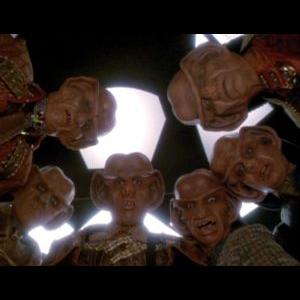
"A child, a moron, a failure, and a psychopath. Quite a little team you have put together!" |
#20
"The Maginificent Ferengi" (DS9)
| 
"A child, a moron, a failure, and a psychopath. Quite a little team you have put together!" |
Say what you will about the Ferengi of The Next Generation, Voyager, and Enterprise, but the way the Ferengi are portrayed in Deep Space Nine is masterful. They are capitalists run completely and ridiculously amok, but they maintain a pride and self-reliance that makes them both formidable and oddly respectable. Having said that, most episodes that focus entirely on the Ferengi get silly and occasionally annoying, but at least once, with the episode "The Magnificent Ferengi," it works really well. Star Trek's answer to The Magnificent Seven, this episode features a motley crew of disparate Ferengi characters, all working together to rescue Quark's mother from the Dominion. The misadventures of these misfits--and how they eventually succeed through a series of fortunate accidents and suicidal gall--is the most amusing episode in this half of the list, but it never degrades into completely ludicrous nonsense. There is a logic to the storytelling that, while funny, never takes leaps into the hopelessly absurd. Besides, it guest stars Iggy Pop as a Vorta. That alone makes it one of the most memorable episodes of Trek.
#19
"Parallels" (TNG)
| 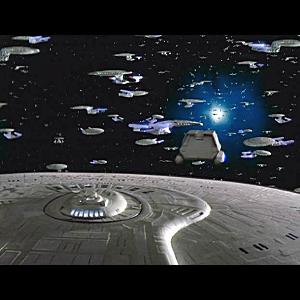
"Captain, we're receiving 285,000 hails." |
#19
"Parallels" (TNG)
| 
"Captain, we're receiving 285,000 hails." |
The "Many-Worlds Interpretation" is a somewhat radical notion in quantum physics that presupposes that every possible outcome (on a quantum level) happens, though each possible outcome splits off into its own unique reality. In essence, there are an infinite (or ridiculously large) number of universes, each one varying from the next by infinitessimal degrees. The Star Trek: The Next Generation episode "Parallels" was one of the first bits of popular science-fiction to elaborate on this specific idea, though the concept of alternate realities has been a staple of the genre for nearly a century (the original series, for example, had the mirror universe). In this episode, Worf finds himself moving through these realities at a gradual pace. At first, the changes are small--the cake suddenly changes from chocolate to vanilla--but over time, the changes become more extreme. Before Worf finds a way back to his original reality, he comes across an existence where he is married (with two children) to Troi, Riker is captain, there is a Cardassian bridge officer, and the Bajorans are a hostile threat. The climax of the episode, in which hundreds of thousands of Enterprises coalesce into a single reality, is particularly awesome.
#18
"Dead Stop" (ENT)
| 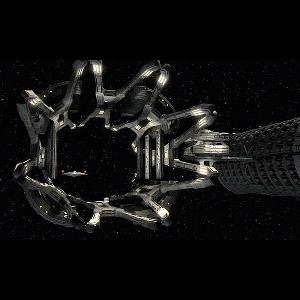
"Your inquiry was not recognized." |
#18
"Dead Stop" (ENT)
| 
"Your inquiry was not recognized." |
The Emmy award-winning "Dead Stop" is a cool idea done well. The Enterprise, damaged after the events of the previous episode, is in desperate need of assistance, and just as things are starting to look especially grim, the crew finds an automated repair station waiting in deep space. The station offers extensive repairs for a pittance, and of course, it is all too good to be true. The station actually uses the brains of sentient beings for its computer core, and as such, a single crew member is the hidden fee behind the deal. In the end, the Enterprise crew manage to save their crewmember and destroy the station, all after getting the extensive repairs it needed. The station, naturally, is seen repairing itself right before the credits roll. This is one of my favorite types of Star Trek episodes, in that it centers on a neat science-fiction concept and sticks through it to a logical conclusion. It is unfortunate that many trekkies are impatient with Enterprise and can't watch it without contrasting it against the other Trek shows, because Enterprise is really interesting science-fiction that dares to try something a little different with the franchise. "Dead Stop" is a perfect example of what the show does well.
#17
"Waltz" (DS9)
| 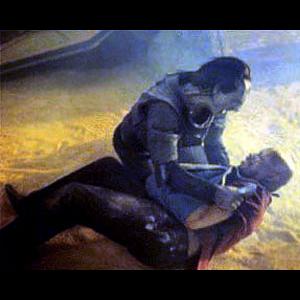
"Sometimes life seems so complicated; nothing is truly good or truly evil. Everything seems to be a shade of grey, and then you spend some time with a man like Dukat, and you realize that there is such a thing as truly evil." |
#17
"Waltz" (DS9)
| 
"Sometimes life seems so complicated; nothing is truly good or truly evil. Everything seems to be a shade of grey, and then you spend some time with a man like Dukat, and you realize that there is such a thing as truly evil." |
"Waltz" is an interesting episode because it is such a tight character piece. It contains no crazy science-fiction weirdness, and it only really focuses on two characters. Additionally, the character most explored and changed by this episode is a villain, Gul Dukat. Dukat, suffering hallucinations, has been stranded on a desolate planet with an injured Benjamin Sisko. Sisko, unable to walk, is effectively trapped by Dukat, who doesn't reveal that he has a working shuttlecraft waiting outside the cave they find themselves in and that the emergency beacon Sisko rests his hopes on is actually turned off. Dukat takes this opportunity to explain himself to Sisko, in the hopes of getting Sisko to understand that he is not an evil man. By the end of the episode, though, it is Dukat who comes to understand himself; he realizes that he is driven by hatred, prejudice, and evil. Rather than reject this, he embraces it fully, and devotes himself from this point on to the eradication of Bajor and the genocide of the Bajoran people. This episode is great because it is a pressure cooker. It relies very heavily on acting, and the two main actors--Marc Alaimo and Avery Brooks--are no slouches. Additionally, it deals with real world problems such as the toll of military occupation and the hidden racism that can lie behind it, not to mention the heavy psychological overtones. And, by highlighting and evolving Gul Dukat, "Waltz" is the episode responsible for making him such a complex and frightening villain.
#16
"Cause and Effect" (TNG)
| 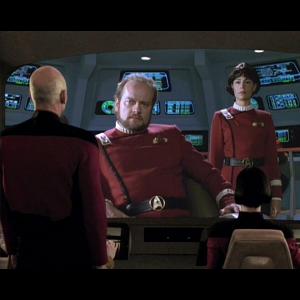
"Captain, perhaps you should beam aboard our ship. There's something we need to discuss." |
#16
"Cause and Effect" (TNG)
| 
"Captain, perhaps you should beam aboard our ship. There's something we need to discuss." |
I still remember watching "Cause and Effect" when it first aired in early 1992. When the Enterprise exploded at the end of the opening teaser for the episode, I knew it was going to be an awesome hour. Indeed, the Enterprise explodes not once, not twice, but four times before the episode is over. The audience is shown a series of events that lead to the presumed end of the Enterprise and then, after a commercial break, the exact same events transpire again, only with a few slight differences. The characters start to remember things before they happen, exhibiting a form of déjà vu that gets stronger and stronger with each repetition of the events. Eventually, the crew is able to figure out that the ship is caught in a "temporal causality loop," a rip in the fabric of spacetime that forces the crew to experience the same events over and over and over again. Despite a few lapses of narrative logic (how do you run a "pattern recognition algorithm on the number 3," and why doesn't the captain try to do both options given him at the final stage of the loop?), the episode is incredibly cool and most certainly unique. Additionally, it turns out, in the end, that Frazier is to blame for everything.
#15
"Statistical Probabilities" (DS9)
| 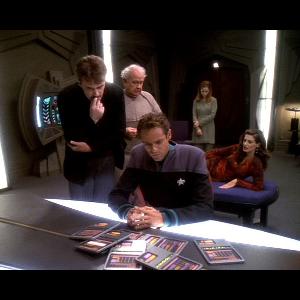
"There are rules, don't talk with your mouth full, don't open an airlock when somebody is inside it, and don't lie about your genetic status!" |
#15
"Statistical Probabilities" (DS9)
| 
"There are rules, don't talk with your mouth full, don't open an airlock when somebody is inside it, and don't lie about your genetic status!" |
Any fan of Isaac Asimov will recognize his influence on the writers of the Deep Space Nine episode "Statistical Probabilities," in which a Cuckoo's Nest-like group of super-intelligent genetically engineered people come to a mathematical conclusion about how future events are destined to transpire. When Dr. Bashir, a genetic mutant himself, becomes convinced that the equations are sound, he goes to Captain Sisko and demands that the Federation surrender in its war against the Dominion, for there is no mathematical way to win and a surrender will ultimately amount to fewer Federation deaths than a defeat. Sisko refuses to accept Bashir's premise, and so the mutants decide to take matters into their own hands. At the last moment, Bashir comes to understand that the calculations cannot possibly account for the actions of any single individual, and thus he escapes and manages to prevent the mutants from negotiating a Federation surrender with the Dominion. The end of the episode is especially poignant, and it highlights the inescapable truth that, no matter how certain things seem, no one can predict the future. In war--and in politics in general--most arguments are based on the assumptions that we can be 100% sure of an outcome. This episode helps us understand that a little uncertainty is a good thing: it's where hope usually rests. It is one of the most eloquent and provocative episode of Trek.
#14
"Timeless" (VOY)
| 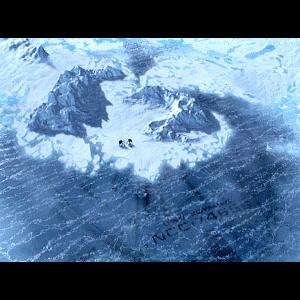
"This is no ordinary phone call, Doc. We're calling yesterday. Timing is everything." |
#14
"Timeless" (VOY)
| 
"This is no ordinary phone call, Doc. We're calling yesterday. Timing is everything." |
It's no secret that I am not a huge fan of Star Trek: Voyager. I think the characters are stilted, the stories are a little too hand-holding, and the whole thing comes across as a sterilized version of The Next Generation with a few minor tweaks. However, I do not hate the show (I have seen every episode, after all), and there are a few good things about it, like the doctor, Jeri Ryan's incredible body, and some of the unique villains (the Phage-infected Vidiians were in the running for a spot on my Top 10 Star Trek Villains a couple weeks ago). The one episode of the show that stands out for me in a positive way is "Timeless," the one-hundredth episode of the show. This episode starts fifteen years in the future of the show, in which Voyager, while attempting a new propulsion system designed to get the crew home, has crashed on an icy planet, killing everyone on board. The only survivors, Harry Kim and Chakotay, made it to Earth in a shuttle, but were so torn apart by survivor's guilt that they quit Starfleet and devoted their time to an unlikely plan to send a message back in time and prevent the disaster. What makes this episode stand out is that it contains some of the best character moments (and acting) of the entire series, especially in terms of Harry Kim (and Garrett Wang, who plays him). The best scene is the final one, in which the younger Harry watches a message from his future alternate-reality self. That's good stuff.
#13
"The Devil in the Dark" (TOS)
| 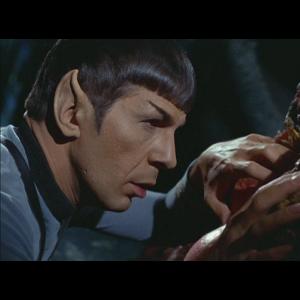
"PAIN! AAIRGH! PAAAAAAIN!" |
#13
"The Devil in the Dark" (TOS)
| 
"PAIN! AAIRGH! PAAAAAAIN!" |
Though I assure you there will be more original series episodes in the second half of this list, "The Devil in the Dark" is the first episode I think of when I think of the original Star Trek. Kirk and Spock beam down to a mining colony that has been attacked by an indigenous--and apparently silicon-based--lifeform. Several people have been killed and the colony is living in a state of panic, unable to do any more mining. Once Kirk and Spock are there, the creature destroys the life support system on the planet, giving them a time limit to their investigation. They eventually find the creature, which is called a Horta, and manage to communicate with it by way of a vulcan mind meld. It turns out that the Horta is acting in defense of its unborn babies, which were being destroyed by the unwitting mining crew. Kirk, Spock, and Bones (who beams down to help heal the creature's phaser wound) manage to negotiate a peace with the Horta, and the miners manage to live side by side with the new silicon-based babies whose natural tunneling ability makes their business exponentially more profitable. It's a great little episode, and if you watch it with your eyes closed, it sounds like an old sci-fi radio program. Episodes like this are what made me fall in love with Star Trek to begin with.
#12
"Unexpected" (ENT)
| 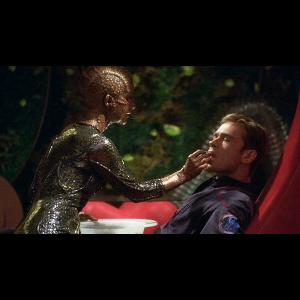
"One of the first things a diplomat learns is not to stick his fingers where they don't belong." |
#12
"Unexpected" (ENT)
| 
"One of the first things a diplomat learns is not to stick his fingers where they don't belong." |
One thing Enterprise does well is showing the alienness and unfamiliarity that awaits in the galaxy. Each show attempts to show these things with varying degrees of success, but Enterprise is the most successful, simply because the crew is so unprepared and inexperienced. In "Unexpected," Trip boards an alien vessel. Not only does he have to take into account varying pressurizations (something that, up until that point, had been completely ignored by Star Trek), but he has to deal with an alien environment that makes him queasy. He also has to familiarize himself with gelatinous water that grows on the walls, a variation of a holodeck, and if all that weren't bad enough, getting pregnant by sharing a special moment with an alien female (though they don't have sex as we know it). Back on board the Enterprise, when he figures out that he is with child, he has to deal with all that it entails, including wild hormones, nipples growing on his arm, a bulge in his torso, and the desperate need to track down the other parent. Of course, when Trip finds her vessel hiding behind a Klingon ship, he then has to face the embarrasment of explaining his condition to a Klingon commander, along with the entire Enterprise bridge crew. The episode makes this list, not just because it is one of the funniest episodes of the show, but because it effectively demonstrates the previously ignored (or taken for granted) complications that arise from alien interactions. The writers put a lot of care into this episode, and it does not go unnoticed by me.
#11
"Q Who" (TNG)
| 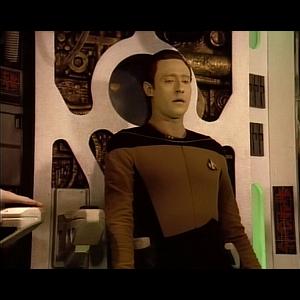
"If you can't take a little bloody nose, maybe you ought to go back home and crawl under your bed. It's not safe out here. It's wondrous, with treasures to satiate desires both subtle and gross. But it's not for the timid." |
#11
"Q Who" (TNG)
| 
"If you can't take a little bloody nose, maybe you ought to go back home and crawl under your bed. It's not safe out here. It's wondrous, with treasures to satiate desires both subtle and gross. But it's not for the timid." |
"Q Who" is the episode that introduced the universe to the Borg. It is a strong episode that is primarily driven by Q, after he is denied a request to join the Enterprise crew, petulantly proving to Captain Picard that humanity isn't ready to face the darkest mysteries of the galaxy. The Borg are, in this episode, a force so formidable that, no matter what the Enterprise does, the Borg is superior. As Q quips, "they are relentless." This episode is mysterious, exciting, and exudes a sense of dread that is unmatched in any other episode of Trek. The fact that it ends with a foreshadowing of more Borg in the near future only makes it that much more jaw-dropping. This episode was much needed proof in the early years of The Next Generation that the show could stand on its own, have a unique new voice, and still be called Star Trek.
(Click here for the rest of this list and learn my picks for the top 10 Star Trek episodes!)
-e. magill 04/27/2009
|
|